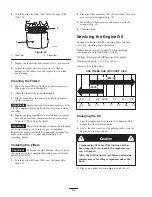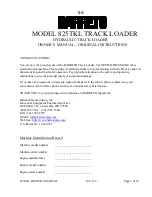
11
Before Operating
Before operating, check the fuel and oil level, and remove
debris from the traction unit. Also, ensure that the area is
clear of people and debris. You should also know and have
marked the locations of all utility lines.
Adding Fuel
Danger
In certain conditions, gasoline is extremely
flammable and highly explosive. A fire or
explosion from gasoline can burn you and others
and can damage property.
•
Fill the fuel tank outdoors, in an open area,
when the engine is cold. Wipe up any gasoline
that spills.
•
Do not fill the fuel tank completely full. Add
gasoline to the fuel tank until the level is 1/4 to
1/2 inch (6 to 13 mm) below the bottom of the
filler neck. This empty space in the tank allows
gasoline to expand.
•
Never smoke when handling gasoline, and stay
away from an open flame or where gasoline
fumes may be ignited by a spark.
•
Store gasoline in an approved container and
keep it out of the reach of children. Never buy
more than a 30-day supply of gasoline.
•
Always place gasoline containers on the ground
away from your vehicle before filling.
•
Do not fill gasoline containers inside a vehicle
or on a truck or trailer bed because interior
carpets or plastic truck bed liners may insulate
the container and slow the loss of any static
charge.
•
When practical, remove gas-powered
equipment from the truck or trailer and refuel
the equipment with its wheels on the ground.
•
If this is not possible, then refuel such
equipment on a truck or trailer from a portable
container, rather than from a gasoline
dispenser nozzle.
•
If a gasoline dispenser nozzle must be used,
keep the nozzle in contact with the rim of the
fuel tank or container opening at all times until
fueling is complete.
Use unleaded gasoline (87 pump octane minimum).
Leaded, regular gasoline may be used if unleaded is not
available.
Important
Do not use methanol, gasoline containing
methanol, or gasohol containing more than 10% ethanol
because the fuel system could be damaged. Do not mix oil
with gasoline.
Using Stabilizer/Conditioner
Use a fuel stabilizer/conditioner in the traction unit to
provide the following benefits:
•
Keeps gasoline fresh during storage of 90 days or less.
For longer storage it is recommended that the fuel tank
be drained.
•
Cleans the engine while it runs
•
Eliminates gum-like varnish buildup in the fuel
system, which causes hard starting
Important
Do not use fuel additives containing
methanol or ethanol.
Add the correct amount of gas stabilizer/conditioner to the
gas.
Note:
A fuel stabilizer/conditioner is most effective when
mixed with fresh gasoline. To minimize the chance of
varnish deposits in the fuel system, use fuel stabilizer at
all times.
Filling the Fuel Tank
1.
Park the traction unit on a level surface, lower the
loader arm, and stop the engine.
2.
Remove the key and allow the engine to cool.
3.
Clean around the fuel tank cap and remove it (Fig. 3).
m-7464
1
Figure 3
1. Fuel cap
4.
Add unleaded gasoline to the fuel tank, until the level
is 1/4-1/2 inch below the bottom of the filler neck
(Fig. 4).
m–7551
2
1
Figure 4
1. Filler neck
2. Fill to 1/4-1/2 inch below
filler neck
Содержание 22308
Страница 6: ...6 Slope Chart Note This page may be copied for personal use only M 4402...
Страница 37: ...37 Schematics Electrical Schematic...
Страница 38: ...38 Hydraulic Schematic...
































